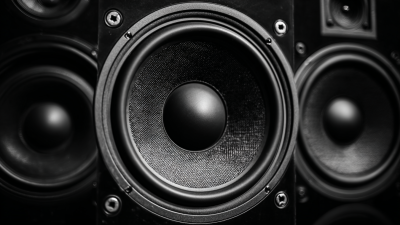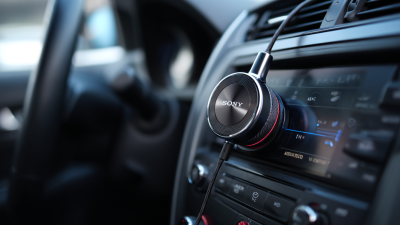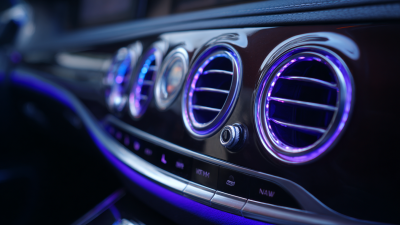Maximize Your Sound Quality Discover How Audio Amplifiers Transform Your Listening Experience
In today's fast-evolving audio landscape, the demand for high-fidelity sound continues to grow, inspiring listeners to seek out the best equipment for an unparalleled auditory experience. Industry reports indicate that the global audio amplifier market is on track to reach $10.4 billion by 2025, highlighting the increasing importance of audio amplifiers in enhancing sound quality. These devices play a crucial role in ensuring that audio signals are accurately reproduced, making them essential for both casual listeners and professional audio engineers. With advancements in technology, modern audio amplifiers not only boost sound levels but also improve clarity and precision, transforming how we experience music, movies, and games. As the quality of listening experiences continues to rise, understanding the functions and benefits of audio amplifiers becomes vital for anyone serious about their sound environment.

Understanding the Role of Audio Amplifiers in Sound Quality Enhancement
Audio amplifiers play a crucial role in enhancing sound quality, significantly transforming the listening experience across various mediums. As the global audio amplifiers and codecs market continues to grow, reaching an anticipated $18.13 billion by 2032, the demand for high-fidelity sound is becoming more pronounced. This increase reflects a broader consumer recognition of the importance of audio clarity, especially in environments where sound quality is paramount, such as in automotive entertainment systems and personal audio setups.
Innovative approaches to audio amplification, such as the use of graphene-infused terracotta in acoustic designs, showcase how technology is evolving to meet this demand. By integrating advanced materials, manufacturers aim to enhance mobile audio performance, offering users richer and more immersive soundscapes. Additionally, compact and affordable solutions, like streaming amplifiers that prioritize sound quality, are becoming increasingly popular, making high-quality audio accessible to a wider audience. This shift emphasizes not only the technical prowess behind audio amplifiers but also the growing importance of superior listening experiences in everyday life.
Types of Audio Amplifiers and Their Unique Features
Audio amplifiers come in various types, each designed to enhance sound quality in unique ways. One primary category is the Class A amplifier, known for its high-quality sound and low distortion. This type operates by always amplifying the audio signal, resulting in a warm and natural sound. However, Class A amplifiers tend to be less efficient, generating more heat and consuming more power, which might not suit all users.
In contrast, Class D amplifiers are celebrated for their efficiency and compact size. These amplifiers utilize pulse-width modulation to deliver power, allowing for a lightweight design without sacrificing performance. While some audiophiles may argue that they compromise on sound quality compared to Class A, advancements in technology have significantly improved their audio fidelity. Other types, such as tube amplifiers, offer a vintage appeal, using vacuum tubes to produce a warm, rich tone that many music lovers appreciate. Each type of audio amplifier has its distinct characteristics, enabling listeners to choose according to their specific preferences and needs for an enhanced auditory experience.
Key Factors to Consider When Choosing an Audio Amplifier
When selecting an audio amplifier, several key factors must be considered to enhance your listening experience effectively. One critical aspect is the amplifier's capability to handle different audio signal types—analog versus digital. In recent years, the shift toward digital audio systems has gained momentum, necessitating a deep understanding of how these amplifiers process sound. Ensuring compatibility with both legacy audio formats and modern digital audio sources is essential for versatility.
Furthermore, the advancement of technology has introduced audio signal processing (DSP) as a significant feature in modern amplifiers. This technology enables real-time acoustic processing, which is vital for applications such as voice recognition and active noise cancellation. By choosing an amplifier with robust DSP capabilities, users can ensure lower latency and more refined sound manipulation, resulting in a superior auditory experience. Additionally, as the automotive audio market continues to grow, understanding the specific requirements of your vehicle can drive better amplifier choices tailored to passenger cars or SUVs.
Setting Up Your Audio Amplifier for Optimal Performance
Setting up your audio amplifier correctly is essential for achieving optimal performance and enhancing your overall listening experience. With the increasing integration of audio amplifiers in smart home devices, their significance has grown notably, leading to a rise in demand and innovation in the industry. The digital audio power amplifier market has shown promising growth, valued at approximately $2.4237 billion in 2023, with projections suggesting an increase to $3.97903 billion by 2032, reflecting a compound annual growth rate (CAGR) of 5.7%.
To maximize sound quality, consider the placement of your amplifier. Positioning it in a well-ventilated area can prevent overheating and ensure longevity. Additionally, connecting high-quality cables directly to your source can reduce signal loss, allowing for clearer sound reproduction.
As new technologies like 8K become mainstream, it’s crucial to have equipment that can handle these advancements. Ensuring that your amplifier is compatible with high-definition formats can drastically elevate your audio experience. Stay informed about the latest upgrades in the market, as manufacturers continuously release new models designed to enhance sound quality and functional performance.
Common Mistakes to Avoid for the Best Listening Experience
When it comes to enhancing your audio experience, avoiding common pitfalls can make a significant difference in your sound quality. Many audiophiles make the mistake of overlooking the importance of proper speaker placement. Speakers positioned too close to walls or corners can lead to an imbalanced soundstage, diminishing the richness of your audio. Instead, take the time to position your speakers at ear level and away from obstructions to ensure an optimal listening environment.
Another prevalent mistake is neglecting to match your amplifier with the speakers' specifications. Using an underpowered amplifier can lead to distortion, while an overpowered one may result in damage to your speakers. Always check the power ratings and impedance of your audio components before making a purchase. Addressing these simple yet crucial aspects will transform your listening experience from mediocre to exceptional, allowing you to fully appreciate the intricate details of your favorite music.
Related Posts
-

Understanding the Unique Features of Coaxial Speakers and Their Benefits
-

Transform Your Drive: Essential Car Audio Accessories for an Unforgettable Sound Experience
-

Ultimate Checklist for Choosing the Best Car Speakers for Your Sound System
-

How to Choose the Best Subwoofer for Your Car Audio System
-

How to Enhance Your Driving Experience with Premium Car Sound Systems
-

8 Essential Tips for Elevating Your Car Audio Experience
